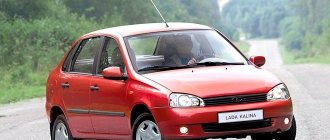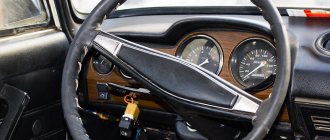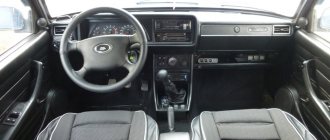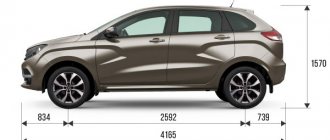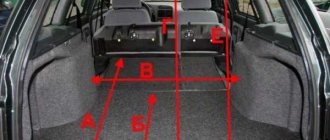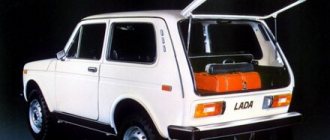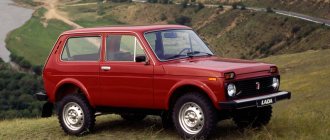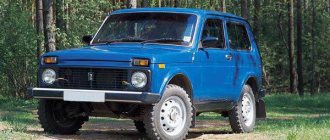In a garage, doing body repairs on a Chevrolet yourself is not an easy task. This procedure includes several sequential actions, each of which requires the presence of a specialized tool, relevant knowledge and “direct” hands.
ATTENTION! A completely simple way to reduce fuel consumption has been found! Don't believe me? An auto mechanic with 15 years of experience also didn’t believe it until he tried it. And now he saves 35,000 rubles a year on gasoline! Read more"
Of course, you may not have to repair your car yourself; fortunately, there are now various Chevrolet body repair services, but the information presented to your attention in this article will be useful to you in any case.
Types of repairs
Depending on the identified defects, Chevrolet body repairs can be divided into three types:
Local, minor repairs:
- straightening minor dents;
- removing scratches and chips;
- restoration of corroded body parts.
Body, complex repairs:
- restoration of geometry and editing of the body;
- straightening and replacement of deformed body elements;
- welding work.
Painting work:
- putty;
- primer;
- painting;
- polishing
Control dimensions, attachment points, body geometry, sections of body parts, gaps, etc.
Engine and suspension mounting points on the body of a VAZ-2121 model car
Mounting points for the engine and suspensions on the body 21214 and 2131
1 – fastening of the front suspension cross member; 2 – mounting of the anti-roll bar; 3 – fastening the rear suspension of the power unit; 4 – transfer case fastening; 5 – fastening of the lower longitudinal rods; 6 – fastening of the upper longitudinal rods; 7 – attachment point for the rear suspension transverse rod. ( )* – size given for body 2131
Engine and suspension mounting points on the body 21214M, 2131M
7 – fastening of rear shock absorbers; 8 – attachment point for the rear suspension transverse rod. ( )* – size given for body 2131M
Dimensions of openings and clearances of mating body parts 2121,21213, 2131
| A | B | IN | G | D | E |
| 1112±5 | 1320±5 | 955±4 | 782±2 | 883±2 | 1710±6 |
| AND | 3 | AND | TO | L | M |
| 938±2 | 1420±4 | 575±2 | 1420±4 | 780±2 | 1395±5 |
| N | ABOUT | P | R | WITH | T |
| 950±4 | 1250±5 | 1090±5 | 855±4 | 480±2 | 570±2 |
Points of attachment of components and assemblies to the body and dimensions between them - VAZ-21213 (clickable)
Sections of body parts
Clearances of the door, hood, lock door with mating parts (indicated in mm.)
Large poster with control points, angles, degrees
Video
Body defects
Before starting any type of repair, it is necessary to conduct a careful and scrupulous inspection of both individual elements and the car itself as a whole, and at the same time try to immediately correct all questionable areas. This procedure is especially relevant when buying a used car.
Paintwork
We carefully check the Chevrolet Niva body colors for uniformity, the transition of color shades from element to element, while paying attention not only to the front side, but also to the internal painted surfaces. The different colors of the interior floor, trunk lid and center pillars should at least give you some thought.
We also identify places where the paintwork is damaged, where it is scratched, chipped, or where corrosion appears.
Gaps
All scattered parts of the Chevrolet Niva body must have symmetrical and identical gaps between each other on each side.
Body geometry
A body type that is load-bearing like a Chevrolet Niva means that it carries all the attached parts of the car. Therefore, special attention should be paid to this stage of the check, since the price of Chevrolet body repairs will negate all the advantages of the car.
We carefully check the side members for traces of welding, painting and for deformations of their surfaces. It is also advisable to take measurements of control points of the body and its openings.
Hanging elements
The trunk lid, hood and interior doors must close and operate in different positions with the same force. The sealed rubber seal must adhere to the surface being closed with its entire plane, even along the edges.
Welding seams
The manufacturer's welds look smooth and not too long, without beads. Body elements are usually welded using spot welding. A sloppy seam is not acceptable in this case.
Fasteners
The heads of bolts, screws and self-tapping screws should not have any traces of unscrewing them or wrenches. Otherwise, it means that the body has undergone repair operations related to the removal/replacement of some elements.
Video review of the Renault Koleos crossover
Control dimensions for checking the geometry of the underbody of a VAZ 2108 (2109, 21099) car
The video will show in detail the interior, exterior, and engine of this crossover.
A significant disadvantage is the rather expensive maintenance. Over the course of three years, you will need at least 70 thousand rubles.
Suzuki SX4
Suzuki SX4
A unique version of the crossover is the unique Suzuki SX4 model, which is not inferior in functionality to large jeeps.
The capacity of this car is significantly less than that of standard crossovers. The trunk has a volume of 270 liters.
Crossover panel rich in optional
GLX equipment: four airbags, heated seats, air conditioning, audio system, roof rails. The price of the Suzuki SX4 is attractive - 780,000 rubles, and T.O. for three years – 35,000 rubles.
Kia Sportage
Kia Sportage
Kia Sportage is recognized as one of the most successful models of recent years, as evidenced by the increased number of these cars on the roads.
Kia Sportage crossover – elegant and reliable
The Kia Sportage crossover combines elegant, impeccable design, reliability and maximum cross-country ability.
The basic equipment of the car includes advanced security systems, electric mirrors, and power steering.
The crossover interior has a comfortable and clear interior design
According to Russian authoritative experts and according to the results of owner surveys, the following crossover models have proven themselves more than worthy:
- Consumer Reports (due to the convenient and clear design of the interior, spaciousness, and the presence of a large number of options);
- Honda CR-V (due to its ultra-efficient braking system, high spaciousness and ease of control);
- Mazda CX-5 (thanks to its ergonomic design, dynamism and low fuel consumption).
Minor body repairs
During vehicle operation, it is almost constantly exposed to aggressive environmental influences. Hail, rain, road ingredients, snow and pebbles flying off from other cars do not at all contribute to the long-term preservation of the paintwork. And if these defects are not corrected in time, they can become potential sources of corrosion, which is what minor Chevrolet body repairs prevent.
This type of repair is advisable if the warranty period has already expired. Here we do not need to take dimensions of the Chevrolet Niva body, nor purchase expensive equipment or tools; we just need to have a spatula, a sponge and an angle grinder.
As a rule, local repairs are aimed at eliminating minor dents, as well as significant chips and scratches. For this:
- My car shampoo has a defective area;
- We degrease it with White Spirit or just gasoline;
- Apply a special automotive putty to the treated area using a soft spatula;
- After the putty has dried, sand the putty area with fine sandpaper;
- Remove any remaining dust, degrease and wipe with a napkin;
- We prime and paint.
In case of repairing minor chips or deep and thin scratches, the puttying stage can be skipped and the primer can be applied directly immediately to a previously degreased surface:
When repairing slight abrasions of the paintwork and in case of its natural aging, these defects are eliminated using an angle grinder and a special paste:
- Apply abrasive paste (No. 1 or No. 2, depending on the depth of damage to the paintwork) to the surface and, as it were, “cover up”* the indicated chips;
- Then, using polishing paste No. 3, polish the treated surface until it becomes shiny;
- Immediately after polishing, without allowing the paste to dry, rinse it off, otherwise it will be very difficult to get rid of its remnants.
*- during the process it is necessary to carefully monitor the temperature of the paintwork, since if it overheats, the varnish can overheat, which will lead to its irreversible darkening and drips.
This procedure is recommended to be carried out under artificial lighting, avoiding direct sunlight. Complex body repair
As a rule, the reason that led to this type of repair is very unpleasant and sad: it is an accident or severe corrosion. The consequences of these reasons are just as significant and look like visible/hidden damage to the body, changes in its geometry and deformation of the side members with the subframe.
Of course, Chevrolet body repair services use only professional equipment to repair such damage: computer automated installations, slipways.
And since we have a great desire to do all the Chevrolet body repairs with our own hands, then even in a garage, we will “stretch” the unified Chevrolet body dimensions to the required ratings, and if necessary, we will turn the car over to repair the underbody. Fortunately, making a slipway with your own hands is not at all difficult, but you still have to buy a hydraulic unit.
The main thing is that when restoring the geometry of the body, the process technology is followed at all stages of the work. And it consists in giving “tension” to the damaged body element and gradually increasing the load (over several hours or even several days) to “bring” the control points to the nominal dimensional parameters.
If necessary, body parts can be tapped and heated, without allowing the metal to “sag” at the heating site.
Preparatory (dismantling) work
Any complex repair involves either dismantling one attachment element or the entire part of the Chevrolet Niva body. For example, when straightening a dent in a door, it will be necessary to remove its trim, and when restoring the geometry of the body, it will be necessary to disassemble the entire interior of the car.
Although this work does not seem so difficult (to break - not to build), in fact it turns out to be very responsible, because then everything will have to be put in place, despite the fact that the Chevrolet Niva body diagram in its non-critical places may change somewhat.
Tin work
Here you need to immediately determine whether the defective element is repairable or not. It may be more appropriate to replace it than to invest a lot of time and money in restoring it. When replacing any element, including replacing the body, it is better to choose a high-quality, factory-made analogue in order to avoid problems with fitting parts.
No painting method
An excellent solution for relatively little money.
Unfortunately, this type of do-it-yourself straightening of a Chevrolet Niva body part is not available to us, since the price of the tool used in the repair is not comparable to the cost of the repair itself.
In addition, you need to have some “luck”, since the deformation of the plane of the element occurring on a stiffener, a weld point, or located in a decorative “groove” makes it impossible to completely restore the part. This means that you will still have to putty, prime and paint the straightened area.
Straightening
This type of repair by default includes puttying, subsequent preparation and painting of the restored part itself. This procedure can be carried out either with a special tool or with improvised means.
| A | Heating the metal |
| B | We plant with a mallet on the camp |
| IN | Removal on shaped tiles |
| G | Heating and upsetting deformations, sequence |
In hard-to-reach places, hidden cavities where it is impossible to reach with a straightening tool, the dent is pulled out with a rod previously “tacked” by welding or with a reverse/inertia hammer, which is then torn off, and the place where it is “tacked” is treated with a grinder.
Corrosion
There are two types of automotive corrosion:
- Superficial;
- Local.
In the first case, we proceed in the same way as in the case of minor repairs described above, that is:
- We clean the damaged area with a grinding machine with a fine-grained abrasive wheel (carefully, without going deep into the main layer of metal). In case of minor corrosion, it will be enough to treat the damaged surface with a rust converter and wash it off after a few hours;
- Degrease;
- We prime;
- We paint and then polish.
In the second case, we have three options for solving the problem:
- Tinning a corrosion stain:
- Soldering or welding a patch:
Chevrolet body repair services
The optimal diameter of the soldered patch is no more than five to seven centimeters. Using a powerful soldering iron, we tin the outer surface of the hole and the edge of the patch with tin (orthophosphoric acid or a rust converter as a flux).
Next, we solder the patch to the hole using a continuous seam, and then hammer it down. We clean the protruding parts with coarse sandpaper, then putty and prepare for painting.
Chevrolet Niva body sizes
- Complete replacement of a damaged body element
Painting a certain part of the body of a Chevrolet Niva and the entire car is too delicate a process. Within the framework of this article, we no longer have time to fully reveal it; let’s try to look at it briefly.
Technical characteristics of the Niva 2131 car
The five-door Lada Niva 4x4 is a compact, unpretentious, reliable SUV designed for transporting passengers and luggage at air temperatures from -40 °C to +45 °C. This car is distinguished by a suspension that provides excellent ride comfort and absolute immunity to road irregularities. The five-door VAZ 2131 is the most spacious car in the Niva 4x4 line.
Dimensions, weight, load capacity
The vehicle has characteristics such as length, width, height. These indicators help the driver assess how much space the car occupies on the road. Length is the distance between the maximum protruding parts in front and behind. The width is determined by the boundaries of the side mirrors. Height is measured from the surface on which the vehicle is located to the highest point on the roof of the vehicle.
All this data is not difficult to find in the vehicle operating manual. Dimensions Niva 2131:
- length – 4240 mm;
- width – 1814 mm;
- height – 1640 mm.
For Niva 2131, the outer minimum turning radius along the axis of the front wheel track is 6.45 m. Equally important indicators are weight (curb weight) and load capacity. The first is the total mass of a set of standard equipment, all necessary consumables (including engine oil, fuel, etc.), as well as the weight of the driver. Baggage and passengers are not included. The 5-door Lada Niva 4x4 weighs 1370 kg.
Payload capacity is the difference between the permissible maximum weight and the curb weight. For Lada Niva 2131, the first indicator is 1870 kg, therefore, the carrying capacity of this vehicle is 500 kg. Permitted maximum weight (PMM) is calculated as the sum of the curb weight of the car and the maximum total weight of luggage and passengers (in the amount provided for by the design).
Custom Options
Technical characteristics of the Niva 2131 include operational features, engine properties and fuel and speed parameters.
Basic data on the model under consideration are presented in the table:
Definition
The vehicle ground clearance (clearance) with a static tire radius of 314 mm (185/75R16) is:
- to the front suspension cross member - at least 221 mm,
- to the rear axle beam – 213 mm.
- front – independent, on wishbones, spring, with hydraulic telescopic shock absorbers and anti-roll bar;
- rear - dependent, lever, spring, with hydraulic telescopic shock absorbers.
For a 4x4 vehicle, the wheels account for 100% of the weight. That is why an all-wheel drive vehicle has a traction force that is approximately 2 times greater than a vehicle with a 4x2 wheel arrangement. Thanks to the front wheels installed at certain angles relative to the body parts and suspension, this car has good stability and controllability. A special feature of the 2131 model is that it prohibits towing a trailer. The motor parameters have the following characteristics:
- Type of power unit - 4-cylinder, in-line, 4-stroke.
- Engine displacement, l – 1.69.
- Power, l. With. – 83.
- Cylinder diameter and piston stroke, mm – 82x80.
- Compression ratio – 9.3.
- Power/ignition system – distributed fuel injection.
According to the operating manual, the maximum engine oil consumption is 0.7 liters per 1000 km. This value indicates wear of engine parts and the need for repairs.
Fuel and speed characteristics of the Lada Niva 2131:
- Filling volume of the fuel tank, l – 65.
- Fuel type – gasoline (AI-95).
- Maximum speed, km/h – 137.
- Acceleration time to 100 km/h, sec. – 19.0.
- with a combined cycle, l/100 km – 11.2;
- in city driving – l/100 km – 12.1;
- in suburban driving – l/100 km – 8.3.
In terms of technical characteristics, the Lada Niva 2131 is not inferior to its more expensive analogues.
Car exterior
Since the start of production of the car, its appearance has remained virtually unchanged. In modern vehicle design, a square body shape, round headlights, and laconic bumpers are a classic option. This model has rear doors on the left and right sides. This makes it easier for passengers to board and disembark. The increased wheelbase increased the smoothness of the ride and reduced swaying around the horizontal transverse axis.
Short body overhangs, as well as non-protruding bumpers, provide the famous geometric cross-country ability of this car. The minimum number of plastic elements reduces the risk of damage, and the ground clearance ensures good cross-country ability in mountainous areas. Additional exterior elements will help ensure the comfort, functionality and safety of the model.
Interior of Niva 2131
The interior of the car is simple but functional. The instrument panel with analog scales and tachometer is quite informative and easy to read due to large digitization. The climate system unit, light control keys and rear window heating are located on the center console. These elements are organized compactly, and there are no problems with their use.
The main advantage of the Lada Niva 2131 4x4 is its spacious interior. The front seats do not have a profile, but optimal rigidity and the presence of lateral support bolsters provide sufficient comfort. The cars are equipped with original convertible rear seats, which allow, if necessary, to increase the luggage compartment area.
The flat floor and wide opening facilitate the transportation of large cargo. The spare wheel is located under the hood, which allows for maximum usable space. The modernization of this car has led to the introduction of air conditioning and electric windows in luxury trim levels.
Advantages and disadvantages of a car
Niva 2131 has proven itself not only in Russia, but also abroad. Car owners have identified both positive and negative characteristics of this car.
Chevrolet Niva
Power steering for VAZ Niva, Chevrolet Niva
Both cars are frameless, with five-door station wagon bodies typical of all-wheel drive vehicles. The Duster has a longer wheelbase - 2673 mm versus 2450 mm for the Chevrolet Niva. It is clear that the additional centimeters allow passengers and luggage to be more comfortably accommodated, and also provide a bonus for stability and smoothness. However, off-road, the plus turns into a minus, significantly worsening the geometric cross-country ability.
The only Chevy engine is capable of producing only 80 horsepower and 127.5 Nm - it won’t show off its dynamics on the highway. And off-road, all hope lies only in the “wide” transmission.
“Duster” is richer in this regard. Three engines to choose from, one of them diesel. By the way, both the younger ones - both the petrol (1600) and the diesel (1500) - are more powerful than the Nivov 1700, and even richer in torque. The power unit is on a subframe, which means less vibration is transmitted to the body.
In terms of transmission, the Niva is a true all-terrain vehicle. The transfer case gives this car two full five-speed rows of gears. And in particularly difficult conditions, locking the center differential helps. Crosspieces on cardan shafts are a thing of the past, giving way to CV joints. Thus, nothing needs to be injected during operation.
The six-speed Duster is a half solution for serious off-road conditions (mud, sand and deep snow). In these conditions, you can at least move forward on the first lower gear, but you won’t be able to go back. Due to lack of torque on the wheels, the clutch will burn out. And the switching pattern with starting on hard roads from the second is not the most convenient. It was easier to remove the low gear from the general row and hide it under the flag - opposite the rear one. Then the asphalt part of the gearbox would turn into a five-speed gearbox with conventionally spaced steps.
If necessary, the electromagnetic clutch automatically turns the car into all-wheel drive - quite convenient. However, if it slips for a long time, for example, in deep snow, it will definitely overheat and for some time transfer all the hardships of fighting off-road conditions to one axle.
The car suspensions are completely different. The Niva has an independent front with parallel levers. The design is traditional for such machines - as they say, time-tested. This ensures a smooth ride at high speed and holds the impact on rough terrain.
The rear suspension is dependent. The design, one might say, is ancient: a beam with five rods (four longitudinal and one transverse) is familiar from the Zhiguli. A special feature of this suspension is its constant ground clearance.
The Duster has a modern and more passenger-friendly McPherson in front. Good on relatively smooth roads, but not durable enough off-road. It is this suspension that provides easy handling with clear reactions and a high smooth ride.
The brakes on the Niva are not the most modern. Disc in front, drum in back. The Duster's front brakes are ventilated discs, more effective at high speeds. The rear ones are drum-type, with a diameter smaller than that of the Niva, which shifts the load to the front ones.
The steering on both cars is power-assisted, which eats up engine power even when the wheels are in the “straight” position.
So, the Chevrolet Niva is a real all-terrain vehicle. Its inherent disadvantages (modest trunk, increased noise and vibration) are due to its purpose and design features.
“Duster”, translated from English as “duster”, exactly corresponds to the name. This is a more comfortable front-wheel drive passenger car with a temporarily connected rear axle. Spacious, with large wheels and good geometric cross-country ability, which allows it to dust on dirt roads more confidently than ordinary passenger cars. But off-road it can’t keep up with the Niva.
Benefits of use
A device such as a subframe has many advantages, the main one of which, as we have already noted, is the reduction of noise and vibrations in the cabin. In addition, this device is the only protection for the lower part of the transfer case.
By the way, on the conveyor the Niva is already equipped with special fastenings to the floor, which allow mounting supports on the transfer case. Thus, installing a transfer case subframe on a Niva will take the car enthusiast no more than 30 minutes. Another thing is to make this part yourself (in this case, the work can take several days).
Also interesting: Niva 2121 transmission: diagram, description, video
UAZ or Niva: differences in suspension design
The UAZ Hunter has a dependent leaf spring suspension, which is distinguished by its reliability when driving on mud and stones, but on the other hand, there is a complete lack of comfort. That is why this car is called the “goat”.
Compared to the Hunter, the ride on the Niva is softer, since the suspension here is different: independent in the front and dependent in the rear. In addition, the Niva also has power steering, ABS brakes and emergency brake assist.
As for the UAZ Hunter, its finishing is even more modest, but there is an opportunity to make tuning based on your taste preferences. Typically, Hunter owners purchase a winch, a protective bumper or a guardrail, and also install an additional trunk or gas tank. Since this is an off-road vehicle, it is usually made as functional as possible for off-road driving.
What dangers can await a motorist while driving?
As practice shows, even such a device as a subframe does not guarantee 100% protection for the transfer case and other components of the car while driving off-road. Therefore, if you often operate the Niva in rural areas, where there is a danger of “picking up” a stump or some other object that is difficult to notice in uncut grass, install the special protection on the subframe that we talked about in the previous paragraph. Then the risk of transfer case deformation will be reduced to zero. If there is no such protection, both the subframe and the box itself will deteriorate.
So, we found out how to make a transfer case subframe for a Niva with our own hands. Whether you need it or not - decide for yourself.


